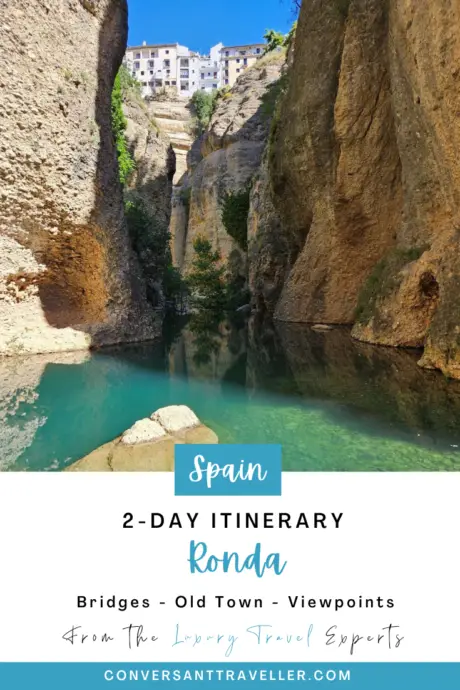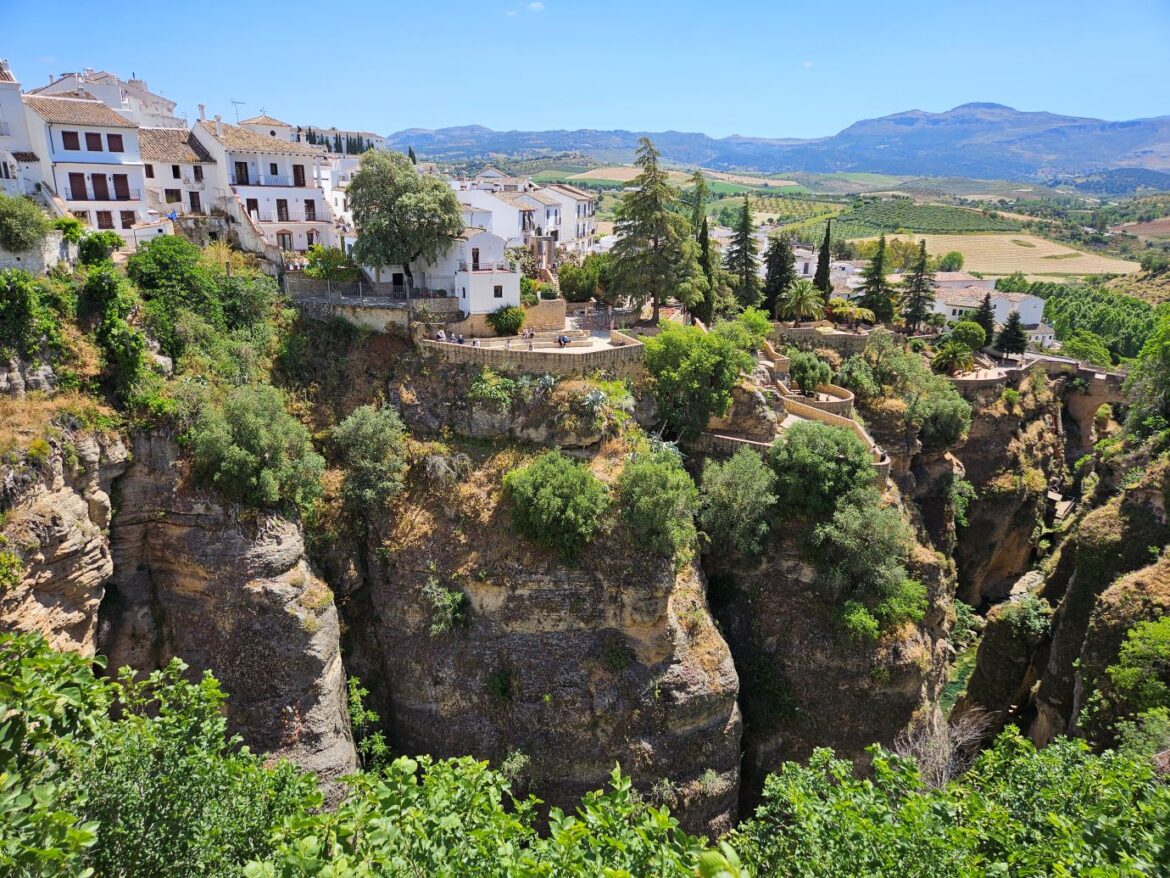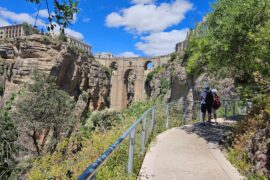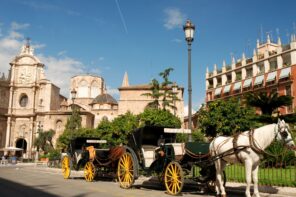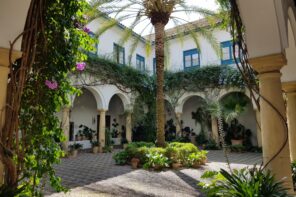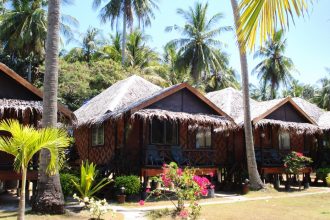Ronda is one of the most beautiful cities in Spain’s Andalucía region, with a dramatic setting up on a high plateau with glorious countryside views that stretch all the way to the mountains. A deep gorge separates the new and old towns, and this photogenic ravine is the focus of many visits to Ronda. It feels delightfully remote here, yet the city is easy to reach from places like Malaga, Seville and Cordoba.
Many people just come here on a day trip, but we think they’re missing out by not staying at least one night in Ronda. By staying overnight, you’ll get to experience Ronda at different times of day (the changing light around the gorge makes for incredible photos) and the city will be quieter in the evenings when the day trippers have left.
We spent 3 nights and 2 full days here because we wanted to explore at a leisurely pace, and just enjoy the relaxed Ronda atmosphere. By doing this we were also able to get our timings spot on when it came to visiting the miradors when the light was best. You won’t have that flexibility if you’re on a day trip, and might end up a bit disappointed if, for example, the New Bridge (Puente Nuevo) is in shadow when you arrive at a particular viewpoint.
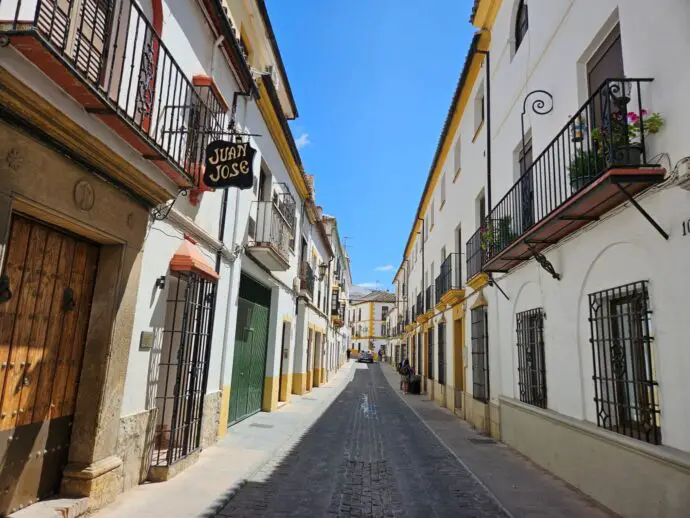
Here’s how we recommend you spend two days in Ronda, taking in the main sights, best viewpoints and a few lesser-visited spots.
Day 1 in Ronda
Morning
Begin your explorations at the Puente Nuevo, which is Ronda’s most famous sight. The views from the bridge are stunning, and you can visit the Aldehuela Viewpoint for close-up views of the bridge from the east side. There is often a busker here, strumming away on a guitar for a bit of added atmosphere. This mirador is often crowded since it’s in the centre of town, but don’t worry if it’s too busy this morning, you’ll have several opportunities to pass by during your 2 days in Ronda for another look.
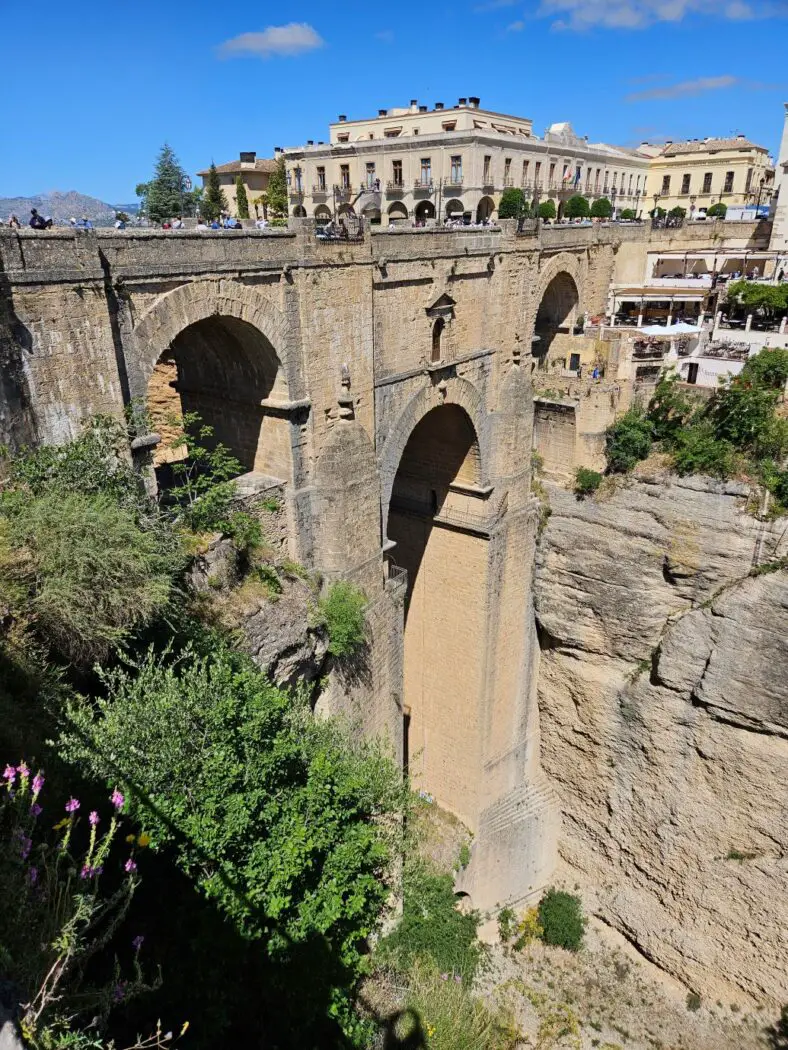
Next, walk down the north side of the gorge to the Jardines de Cuenca. These gardens are named after the city of Cuenca, which was twinned with Ronda in 1975. It’s a peaceful spot with incredible views of the gorge and the pretty white houses that teeter on the edge of the cliffs. This is the best place to take photos of the Puente Viejo (Old Bridge) too.
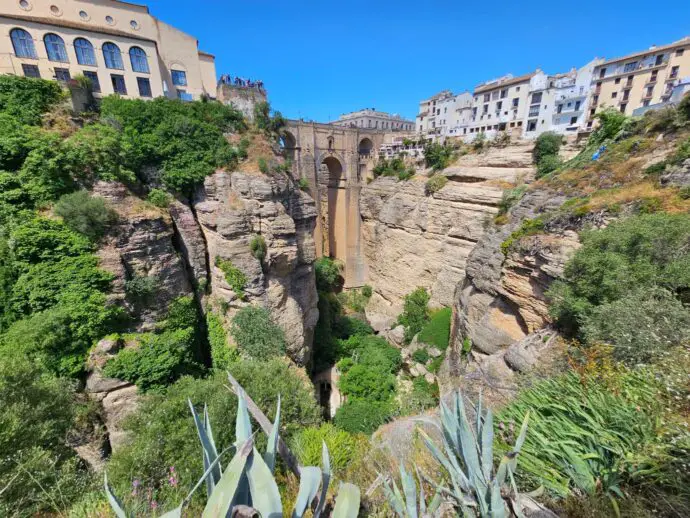
Continue walking down the gorge until you reach the Puente Viejo. This old bridge was used to cross the gorge before the Puente Nuevo was built, and now serves as a convenient entrance into the old town. You can see the even older Puente Arabe (Arab Bridge) just below, which is now surrounded by irrigation channels and farmland.
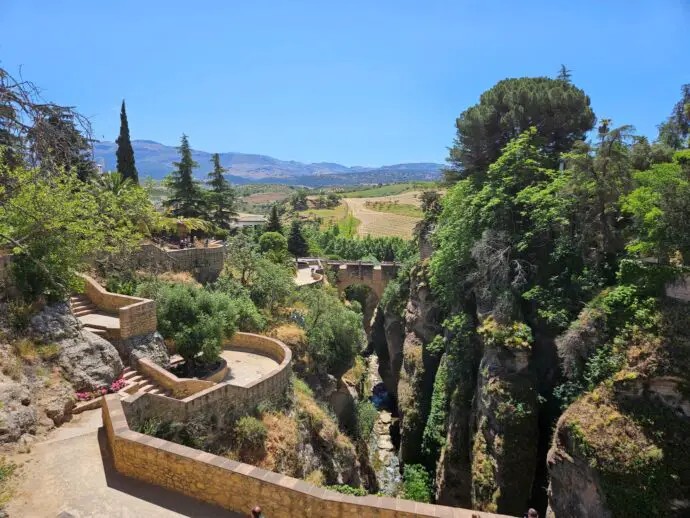
Whilst you’re down here, visit the Arab Baths (Baños Arabes). These thermal baths were built down by the stream so there was a constant supply of water for the cleansing steam. There were bathing areas with cold, warm and hot water, beneath lofty vaulted ceilings decorated with star-shaped skylights. It reminded us of the Arab Baths in Granada and many places we’ve visited in Morocco, including the cistern in El Jadida. It’s a beautiful place, and one of the best attractions in Ronda, surrounded by green fields, streams, and grazing horses.
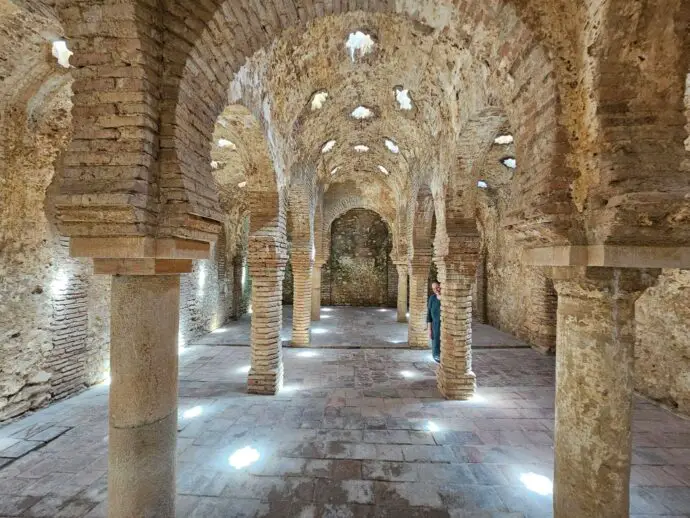
Now walk back to the Puente Viejo, and head up into the old town, walking through the Arco de Felipe V. Keep left, and cut down one of the little alleyways to the old city walls – you can walk along these walls all the way to the town hall area. The views from the walls are incredible, with sweeping vistas out across the countryside. There’s even an old tower you can climb up for some of the best panoramas in Ronda.
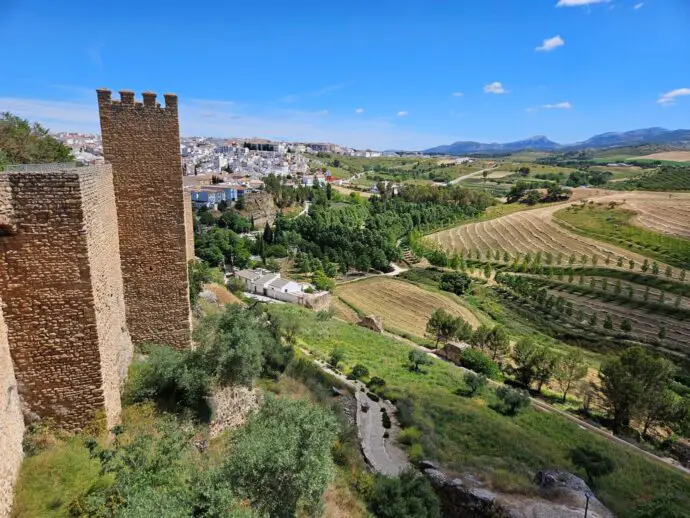
Lunch
Stop for a relaxing lunch at La Vendimya Cafe Restaurant in the beautiful gardens of Hotel Boutique Palacio de la Duquesa. It’s a tranquil haven of greenery and countryside views, right in the heart of the city, with patio tables and delicious dishes of Iberian ham, ratatouille and patatas bravas. This place had just opened when we visited, and we loved it so much we actually ate there several times during our stay.
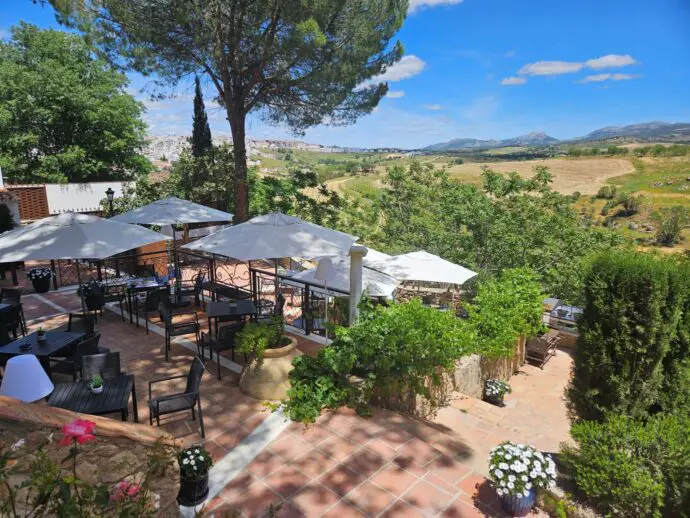
Afternoon
After lunch, pop into the Iglesia del Espiritu Santo next door. It’s a beautiful old church, built into the city walls in 1505 on the orders of King Ferdinand, and was Ronda’s main place of worship before the completion of the Iglesia Santa Maria.
Keep walking along the road, and you’ll come to the ancient 13th-century city gate – the Puerta de Almocabar. This traditional Moorish gate used to be the main access point for the city.
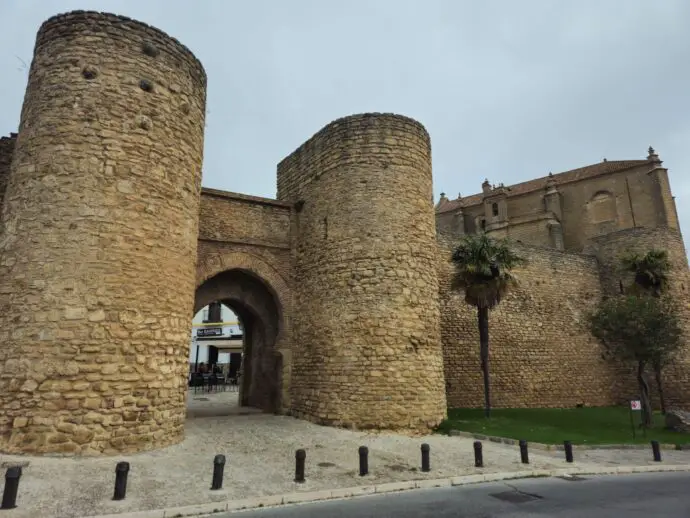
Head through the gate and back into the old town to Plaza Duquesa, a lovely green square with trees, a fountain and shady spots with a few benches.
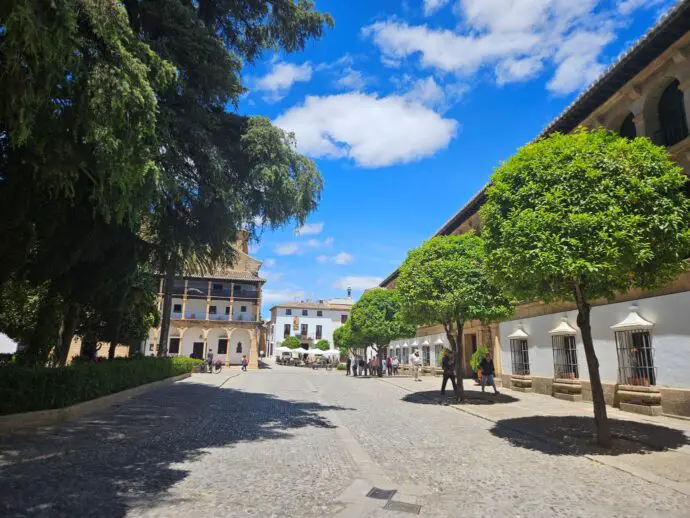
You can pop into Iglesia Maria Auxiliadora if you like, which is a another pretty church to the south of the square. However, the main attraction here is Iglesia de Santa Maria la Mayor, Ronda’s main church. It costs €4.50 to enter.
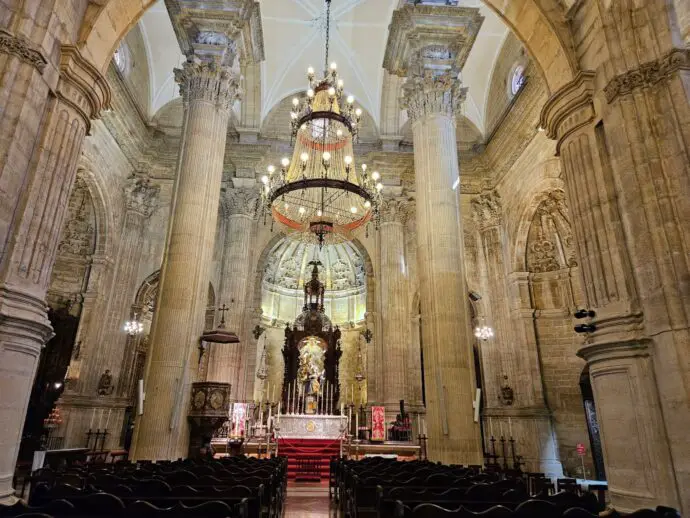
The inside is pretty spectacular, but the best bit is the roof terrace which can be accessed by climbing up the tower. The views out over the city rooftops are well worth the church entrance fee, and the effort!
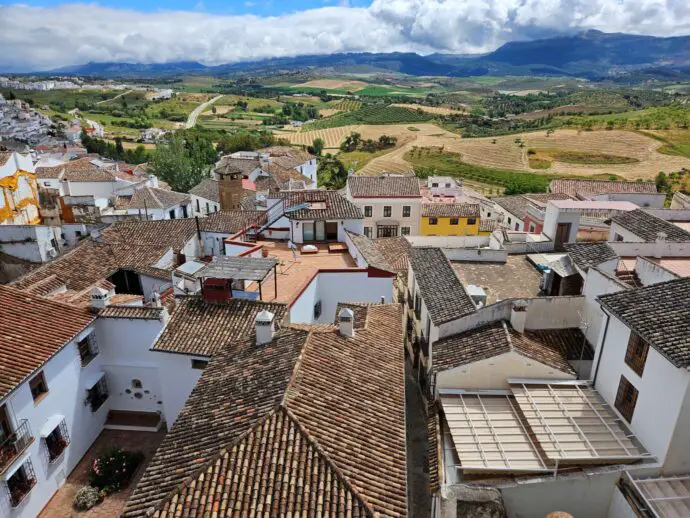
Explore the pretty streets of the old town, and make your way to Palacio de Mondragon, just a short walk from Plaza Duquesa. If you’re not really a fan of historic buildings, you can miss this one out as there will be other attractions with better views coming up shortly. This 14th-century palace is now a museum, with lovely gardens, countryside views, patios and balconies. It’s said that King Ferdinand and Queen Isabella lived here after conquering Ronda during the 15th century.
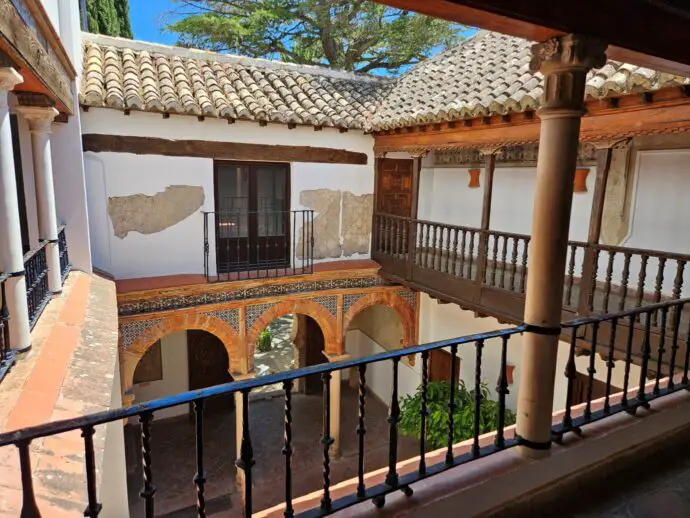
Continue walking around the western edge of the old town, passing Plaza de Maria Auxiliadora (you’ll be back here tomorrow!) and enjoying the photogenic buildings that line Calle Tenorio (one of the prettiest streets in the old town).
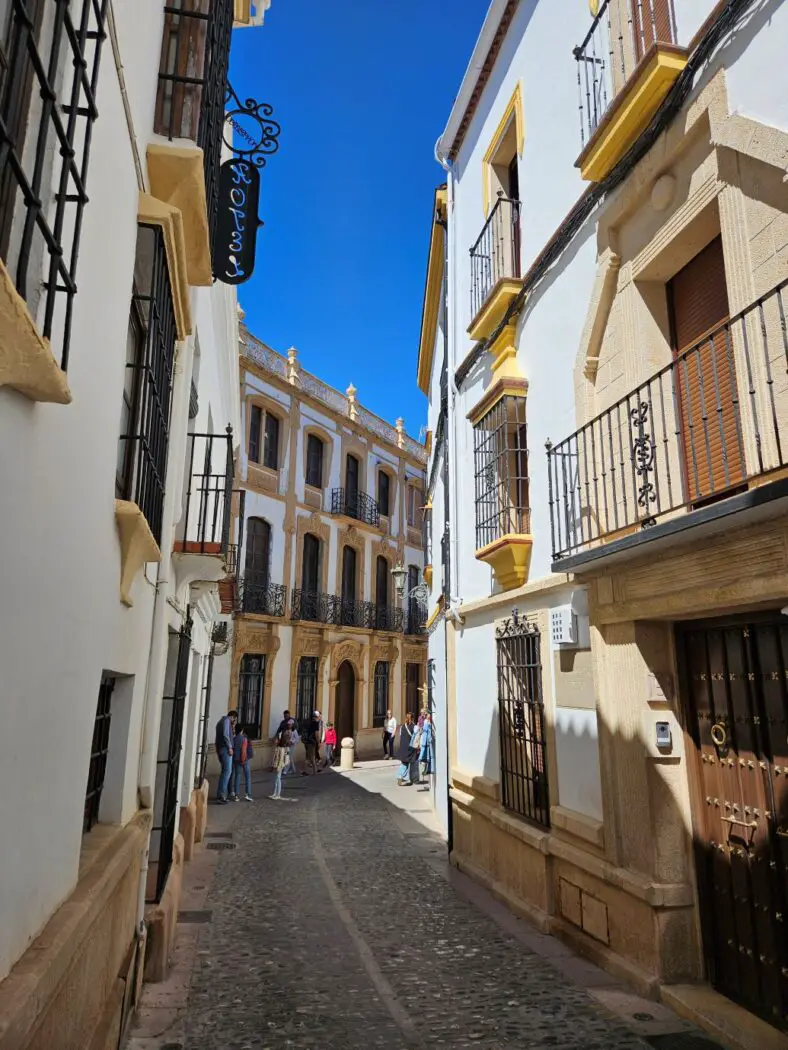
Along Calle Tenorio, you’ll find Casa Museo Don Bosco – a mansion-turned-museum with beautiful terraced gardens and great views of the countryside. You can also see the Puente Nuevo from here, although it’s not worth visiting for that view alone as there are far better angles from other miradors. The mansion was built in 1850, and has lots of modernist features which were added in the 20th century. There’s lots of beautiful ceramic tiling, old tapestries and carved furniture which gives a good flavour of the city’s rich heritage. There’s a garden café and toilets here too.
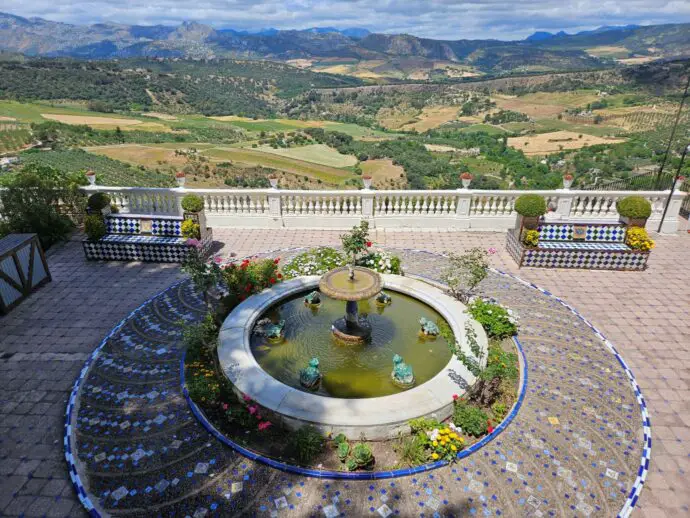
If you’re not yet exhausted, there are a few other places you can visit in the old town. Iglesia de Nuestra Senora de la Paz was a hermitage in the 16th century, and today the church remains dedicated to the patron of Ronda. We liked the attractive brickwork on the exterior and the rich guilded images inside. Meanwhile, Casa de Gigante is a restored Nasrid Dynasty house with a pretty courtyard and traditional Islamic architecture.
Evening
Back in the centre of Ronda, enjoy refreshing glasses of sangria or some local beer at the Hotel Catalonia roof terrace bar. This has to be the bar with the best views in town as it overlooks the bullring as well as the beautiful surrounding countryside. You can sit right along the edge of the terrace at Hotel Catalonia with front row seats to the scenery.
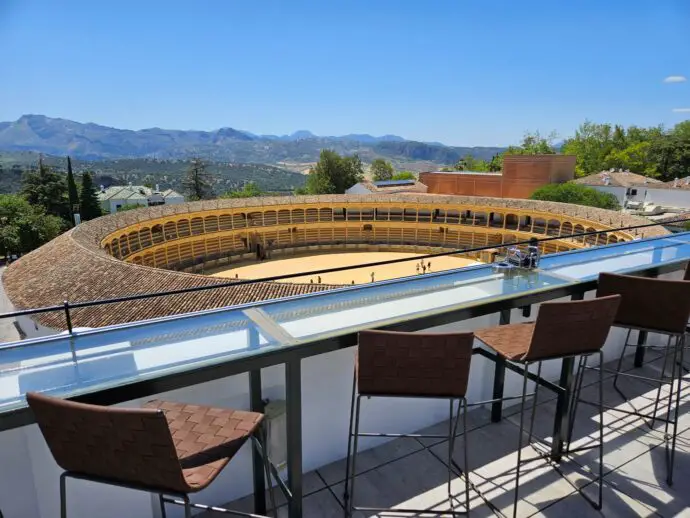
Then enjoy a stroll along the nearby Paseo de los Ingleses where the sunset views over the sprawling countryside are so beautiful. You can also check out the Mirador de Ronda in the Paseo de Blas Infante park, which is just across the square from the Hotel Catalonia.
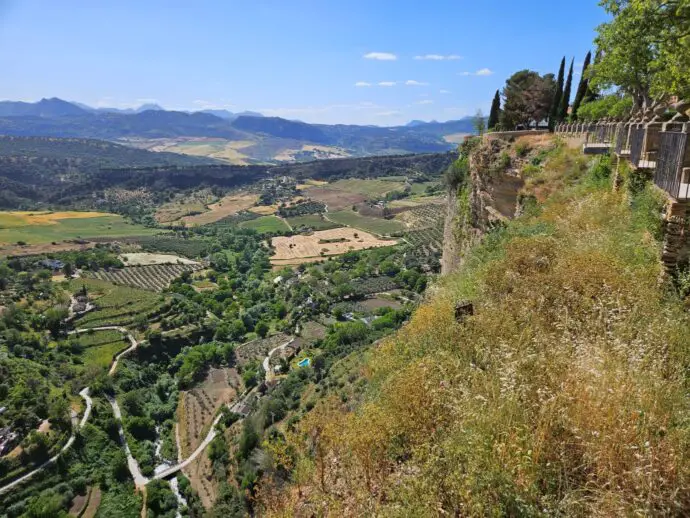
For dinner, pop around the corner to nearby Carrera Oficial, a beautifully designed small restaurant, serving both tapas and a la carte meals with a Spanish and Mediterranean theme. We loved the mix of elegant, upscale dishes, super friendly staff and surprisingly decent prices, and highly recommend a meal here at Carrera Oficial. In fact, it cost us less than a mediocre meal at one of the ‘cheap’ tourist restaurants a few streets away. Definitely our favourite restaurant in Ronda!
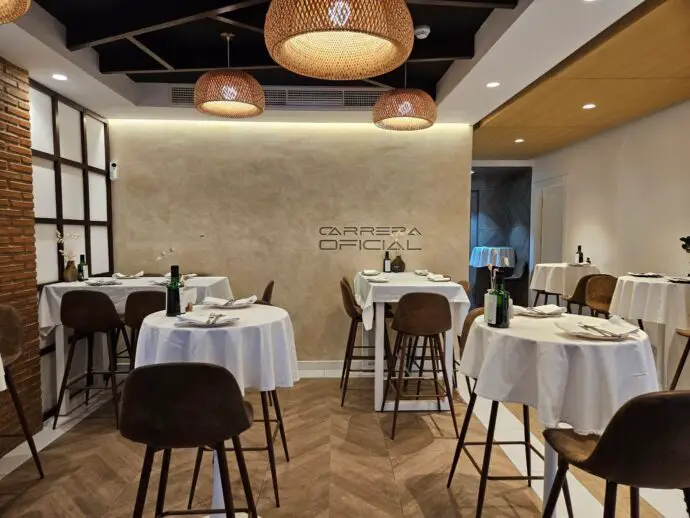
Day 2 in Ronda
Morning
After a leisurely breakfast and perhaps another visit to the Mirador de Aldehuela by the Puente Nuevo, head to Casa del Rey Moro, on the south side of the gorge. If you’ve heard peacocks calling as you wander around the town, this is where they live! Along with the Arab Baths, the Casa del Rey Moro was the attraction we enjoyed the most (aside from the bridge views of course!). The house itself is closed (renovations have not yet been completed) but it’s the gardens and the water mine that you’re here for.
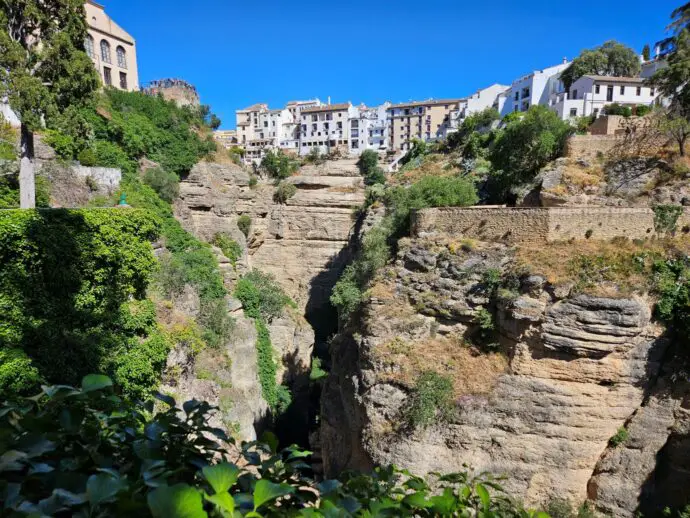
The terraced gardens are full of tiled benches, beautiful flower beds, fountains and pergolas, as well as a resident family of peacocks who might strike up a pose if you’re patient. You’ll also enjoy some of the best views of the Tajo Gorge in Ronda from these terraces.
But the best part is the water mine. Carved into the cliffs of the gorge, the mine was built in the 14th century by Christian slaves to provide water to Ronda’s inhabitants during times of siege. There are around 300 steps that take you down to the bottom of the gorge, passing through slightly spooky several chambers on the way.
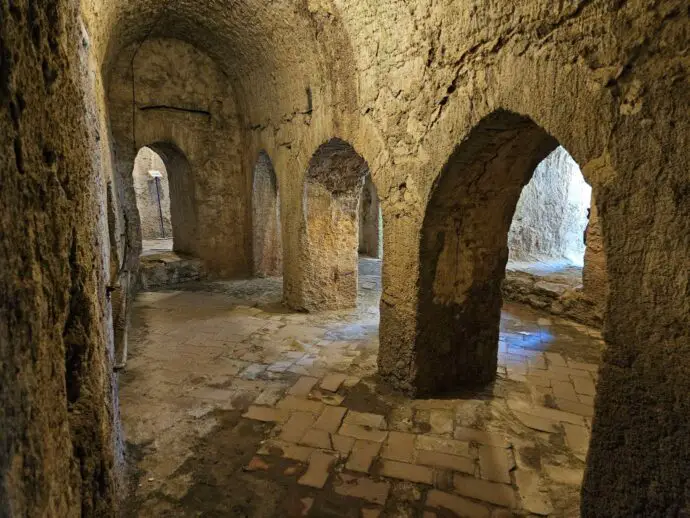
At the end, your efforts are rewarded by a unique and rather spectacular view of the river and the cliffs above. Just be warned, the steps are steep, dark, and sometimes slippery, so this isn’t a challenge for anyone who isn’t feeling particularly fit, or those with dodgy knees. It was exhausting walking back up!
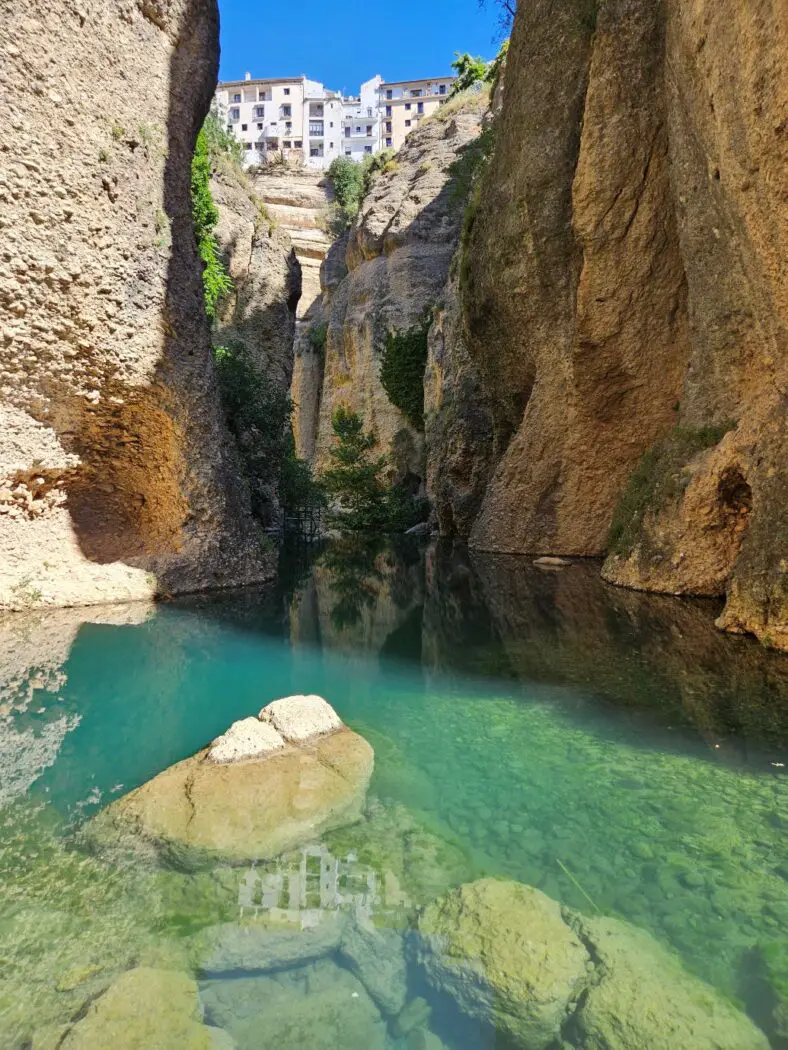
Lunch
There’s a terrace café serving up light lunches in the gardens of Casa del Rey Moro, with gorgeous views overlooking the gorge. It seems much quieter at this end of the gorge than up by the New Bridge, so Terraza Casa del Rey Moro is a peaceful spot for tucking into tapas or enjoying a cold lemonade.
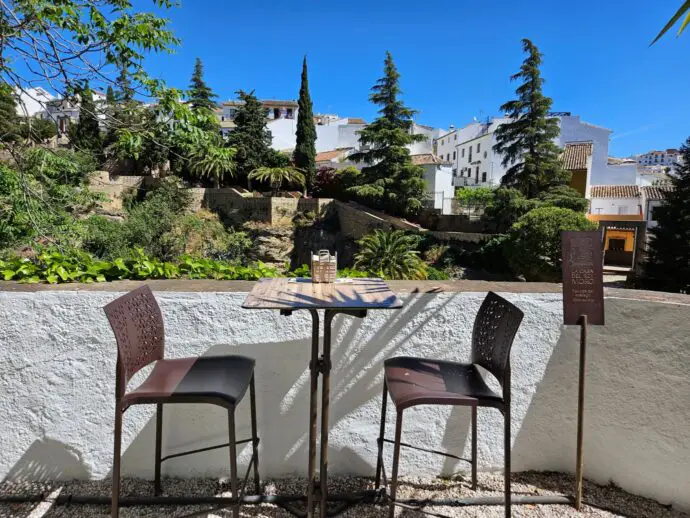
Afternoon
Saving the best until last, this afternoon is all about the Puente Nuevo and hiking down to one of the best viewpoints in Ronda. Make your way to the Plaza de Maria Auxiliadora, on the western edge of the old town. It’s just a couple of minutes’ walk from the New Bridge. From there, take the trail down into the gorge, all the way to the old Arab Arch and the Ronda Bridge Viewpoint. This is where all those iconic photographs of the Ronda Bridge are taken from, and if you only visit one viewpoint, make sure it’s this one!
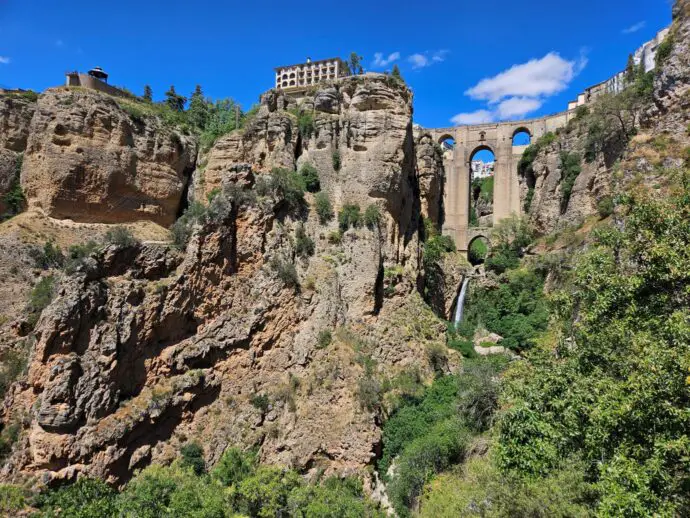
It’s a steep path, and there’s hardly any shade so make sure you carry water with you. It’s definitely a hot slog coming back up again, so do take your time. I wouldn’t normally suggest doing a walk like this in the heat of the day, but the sun is shining on this side of the bridge during the afternoon and evening, so if you want good photos, it really is the best time to go. We had planned on doing this in the morning (on our May visit) but the bridge was in shadow so we decided to wait.
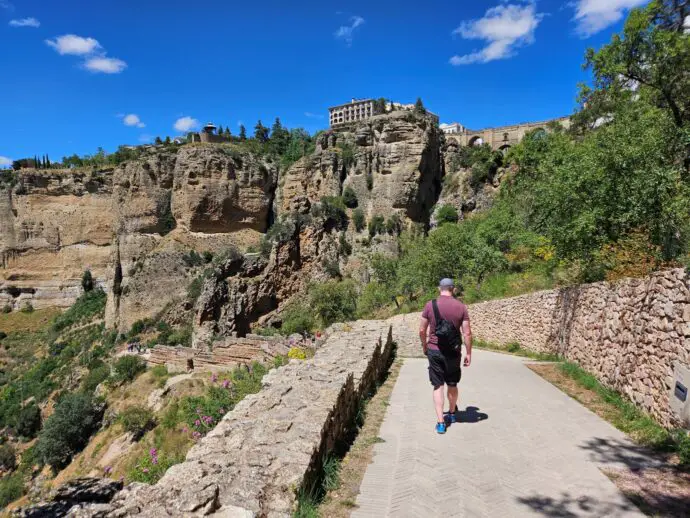
Half way down this path, between the plaza and the Arab Arch, is the entrance to the Camino del Desfiladero del Tajo. This short walk takes you along the edge of the cliff down to the base of the Puente Nuevo, with close-up views of the waterfall and the bridge along the way. I’ve written this post about whether the Camino del Desfiladero del Tajo is worth it, considering that there’s a €5 entry fee. The views are similar to the ones from the Arab Arch, but if you’re not keen on hiking all the way down there (or back up again!) then the fee could be worth paying.
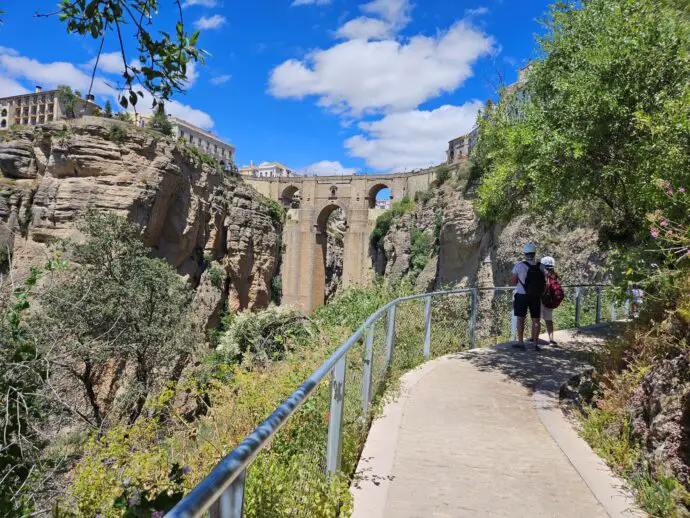
After climbing back up to the plaza, walk back over the New Bridge and enjoy a cool drink in one of the cafes in the Plazza del Socorro. It’s a great place for people watching, and the building architecture here is beautiful.
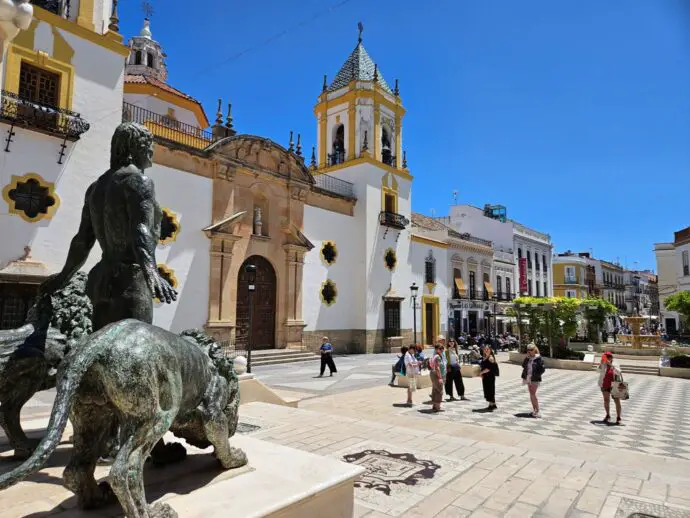
Then, if you still have energy left, you could visit Ronda’s Bullring, just a couple of streets away. It’s not for everyone, so make your own mind up about this. Personally, we don’t agree with bullfighting, but we appreciate that the tradition is an engrained part of Spanish heritage. Built in the 18th century and considered to be the centre of ‘modern’ Spanish bullfighting, today, the bullring in Ronda is a museum. If you’d rather not visit (it does cost €9), you can enjoy a great view from the roof bar at Hotel Catalonia, all for the price of a drink.
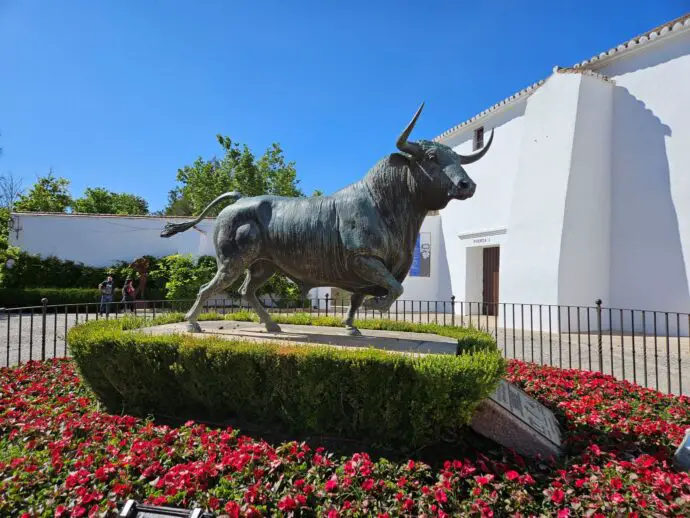
Evening
For a musical start to your evening, Casa Museo Don Bosco holds flamenco concerts at 7pm every day between March and June, and also September and November. The grand salon is a beautiful backdrop to the music, and before the performance begins, you can enjoy views of the evening light across the valley from the gardens. The flamenco concerts last around 50 minutes.
Treat yourself to dinner at Sensur Gastrobar this evening, as a reward for all the walking you’ve been doing! It’s a beautiful modern restaurant serving Spanish dishes with a contemporary twist, located off Plaza del Socorro in the new town (funnily enough, just around the corner from Carrera Oficial).
Best time to visit Ronda
The best time to go to Ronda is during the spring and autumn. April to June, September and October are ideal, with warm weather and fewer tourists than during the summer. We visited in May and thought it was the perfect time – it was warm but not too hot for us Brits, the flowers were blooming in the gardens, and we didn’t find it too crowded.
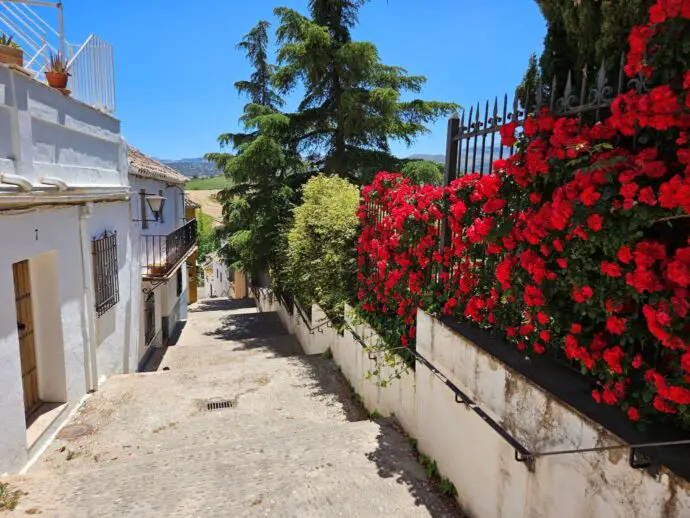
Where to stay in Ronda
Hotel Catalonia Ronda – this is where we stayed and it was the perfect location for sightseeing – it’s right in the centre of the city, less than 200 metres from the Puente Nuevo. Rooms are stylish and super comfortable (some have a little balcony over the street), and there are incredible views of the city and surrounding countryside from the rooftop bar and infinity pool. Honestly one of the best hotels we’ve stayed at in Spain.
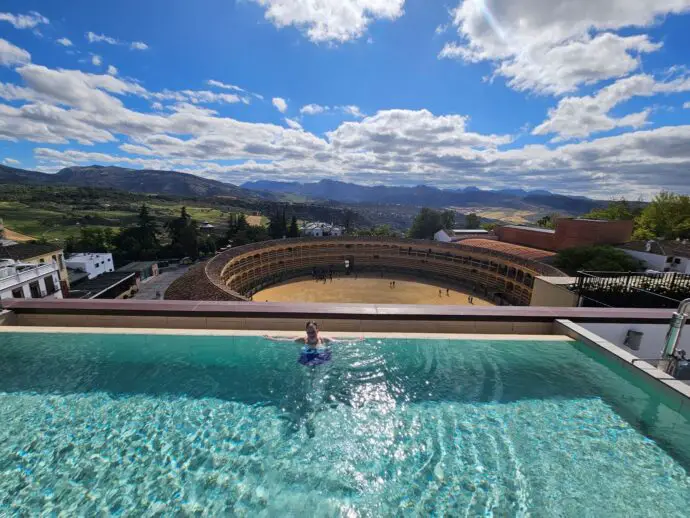
Hotel Boutique Palacio de la Duquesa – this newly opened beautiful boutique hotel is tucked away in a peaceful location on the edge of the old town. The hotel sits in 2,000 square metres of ground, with lovely countryside views and a gorgeous swimming pool. Rooms are stylish and modern, and the terrace restaurant is one of the best places to eat in the city.
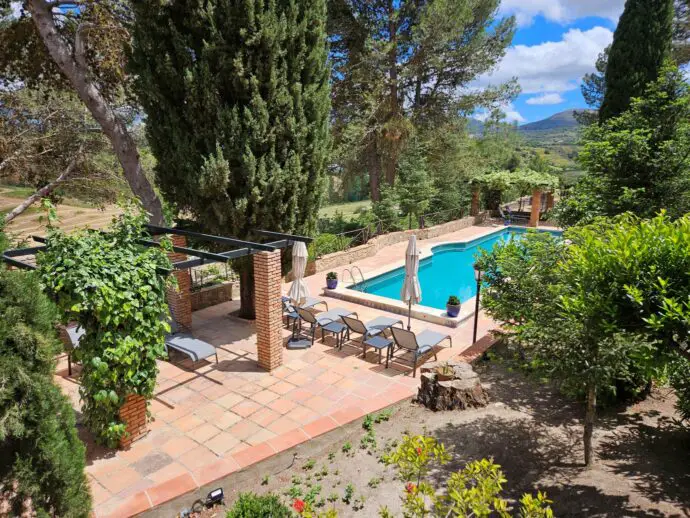
Parador de Ronda – this is one of Spain’s famous parador hotels, and enjoys an enviable location right on the edge of the gorge overlooking the Puente Nuevo. There’s an outdoor terrace and swimming pool, as well as a couple of restaurants. Ask for a corner room for the best views.
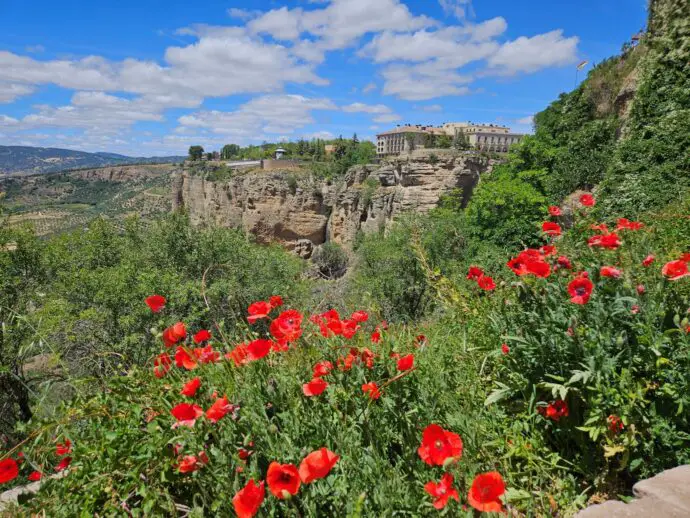
Hotel Palacio de Hemingway – this historic hotel is in the heart of the old town, on some of the city’s prettiest streets. It’s just 50 metres from the Punete Nuevo so is perfectly located for sightseeing. Interiors are smart with dark wood furniture giving an elegant old school vibe, and many of the rooms have balconies with views of the New Bridge.
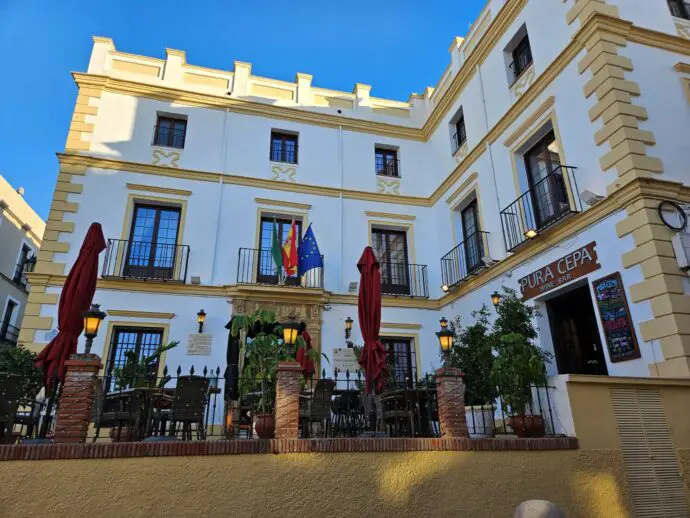
Apartamento Balcones del Tajo – if you’re looking for a self-catering spot with superb views overlooking the Puente Nuevo and El Tajo Gorge, try this place. It’s further along the cliffs from the main road so is quieter than the places right next to the bridge, and the views are better! There’s a balcony as well as fully equipped kitchen, living room and bedroom.
Tips for visiting Ronda
- Dinners are served late in Spain, with many restaurants not opening until 8pm, or sometimes later. Which is hard going for us Brits who are used to eating much earlier. We suggest eating something a bit more hearty than a sandwich at lunch time, to see you through until the end of the day.
- Some places close for siesta in the afternoons, including museums, restaurants and cafes. This is generally between 2 and 5 PM although does vary between establishments.
- The best way to get around Ronda is on foot. The sights and attractions are relatively close together, but you will end up doing a lot of walking, so pack comfy footwear.
- It’s best to arrive by train (the centre is only a 10 minute walk from the train station) or bus from one of the bigger cities like Malaga or Seville. If you have a car, parking can be a bit of a nightmare and the streets are narrow and difficult to drive along. It’s probably best to park on the edge of the city and walk in from there.
Found this 2-day Ronda itinerary useful? Pin it for later…
